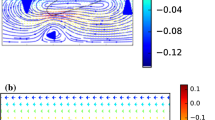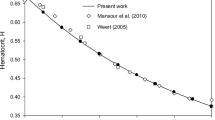Abstract
Blood contains a high vol fraction of erythrocytes (red blood cells), which strongly influence its flow properties. Much is known about the mechanical properties of red cells, providing a basis for understanding and predicting the rheological behavior of blood in terms of the behavior of individual red cells. This review describes quantitative theoretical models that relate red cell mechanics to flow properties of blood in capillaries. Red cells often flow in single file in capillaries, and rheological parameters can then be estimated by analyzing the motion and deformation of an individual red cell and the surrounding plasma in a capillary. The analysis may be simplified by using lubrication theory to approximate the plasma flow in the narrow gaps between the cells and the vessel walls. If red cell shapes are assumed to be axisymmetric, apparent viscosities are predicted that agree with determinations in glass capillaries. Red cells flowing in microvessels typically assume nonaxisymmetric shapes, with cyclic “tank-treading” motion of the membrane around the interior. Several analyses have been carried out that take these effects into account. These analyses indicate that nonaxisymmetry and tank-treading do not significantly influence the flow resistance in single-file or two-file flow.
Similar content being viewed by others
References
Chien, S. (1975), Biophysical behavior of red cells in suspension,The Red Blood Cell, vol. 1, Surgenor, D. M., ed., Academic, New York, pp. 1031–1133.
Schmid-Schönbein, G. W., Sung, K. P., Tozeren, H., Skalak, R., and Chien, S. (1981), Passive mechanical properties of human leukocytes,Biophys. J. 36, 243–256.
Lighthill, M. J. (1968), Pressure-forcing of tightly fitting pellets along fluidfilled elastic tubes,J. Fluid Mech. 34, 113–143.
Barnard, A. C. L., Lopez, L., and Heliums, J. D. (1968), Basic theory of blood flow in capillaries,Microvasc. Res. 1, 23–34.
Lin, K. L., Lopez, L., and Heliums, J. D. (1973), Blood flow in capillaries,Microvasc. Res. 5, 7–19.
Secomb, T. W. and Gross, J. F. (1983), Flow of red blood cells in narrow capillaries: role of membrane tension,Int. J. Microcirc. Clin. Exp. 2, 229–240.
Secomb, T. W., Skalak, R., Özkaya, N., and Gross, J. F. (1986), Flow of axisymmetric red blood cells in narrow capillaries,J. Fluid Mech. 163, 405–423.
Skalak, R. (1981), Blood rheology,Mathematical Aspects of Physiology (Lectures in Applied Mathematics, Vol 19). Hoppensteadt, F. C., ed. American Mathematical Society, Providence, RI, pp. 109–139.
Zarda, P. R., Chien, S., and Skalak, R. (1977), Interaction of viscous incompressible fluid with an elastic body,Computational Methods for Fluid-Solid Interaction Problems, Belytschko, T. and Geers, T. L., eds., American Society of Mechanical Engineers, New York, pp. 65–82.
Secomb, T. W. (1987), Flow-dependent rheological properties of blood in capillaries,Microvasc. Res. 34, 46–58.
Evans, E. A. and Skalak, R. (1980),Mechanics and Thermodynamics of Biomembranes, CRC., Boca Raton, FL, pp. 67–141.
Hochmuth, R. M. and Waugh, R. E. (1987), Erythrocyte membrane elasticity and viscosity,Ann. Rev. Physiol. 49, 209–219.
Evans, E. A. (1983), Bending elastic modulus of red blood cell membrane derived from buckling instability in micropipet aspiration tests,Biophys. J. 43, 27–30.
Chien, S., Sung, K.-L.P., Skalak, R., Usami, S., and Tözeren, A. (1978), Theoretical and experimental studies on viscoelastic properties of erythrocyte membrane,Biophys. J. 24, 463–487.
Secomb, T. W. and Hsu, R. (1987), Effect of assumed stress-free configuration of red blood cell membrane on capillary blood rheology,Fed. Proc. 46, 1060.
Secomb, T. W. (1988), Interaction between bending and tension forces in bilayer membranes,Biophys. J. 54, 743–746.
Timoshenko, S. (1940),Theory of Plates and Shells, McGraw-Hill, New York.
Cameron, A. (1966),The Principles of Lubrication, Wiley, New York. p. 61.
Tözeren, H. and Skalak, R. (1978), The steady flow of closely fitting incompressible elastic spheres in a tube,J. Fluid Mech. 87, 1–16.
Wang, H. and Skalak, R. (1969), Viscous flow in a cylindrical tube containing a line of spherical particles,J. Fluid Mech. 38, 75–96.
Halpern, D. and Secomb, T. W. (1991), Viscous motion of disc-shaped particles through parallel-sided channels with near minimal widths,J. Fluid Mech. 231, 545–560.
Dvinsky, A. S., and Popel, A. S. (1987), Motion of a rigid cylinder between parallel plates in Stokes flow: Poiseuille and Couette flow,Computers & Fluids 15, 405–419.
Skalak, R. and Branemark, P.-I. (1969), Deformation of red blood cells in capillaries,Science 164, 717–719.
Gaehtgens, P., Dührssen, C., and Albrecht, K. H. (1980), Motion, deformation and interaction of blood cells and plasma during flow through narrow capillary tubes,Blood Cells,6, 799–812.
Lingard, P. (1979), Capillary pore rheology of erythrocytes: The glass capillary array-effect of velocity and hematocrit in long bore tubes,Microvase. Res. 17, 272–289.
Driessen, G. K., Fischer, T. M., Haest, C. W. M., Inhoffen, W., and Schmid-Schönbein, H. (1984), Flow behaviour of rigid red blood cells in the microcirculation,Int. J. Microcirc. Clin. Exp. 3, 197–210.
Lee, J. S. and Fung, Y. C. (1969), Modeling experiments of a single red blood cell moving in a capillary blood vessel,Microvasc. Res. 1, 221–243.
Canham, P. B. and Burton, A. C. (1968), Distribution of size and shape in populations of normal human red blood cells,Circ. Res. 22, 405–422.
Halpern, D. and Secomb, T. W. (1989), The squeezing of red blood cells through capillaries with near-minimal diameters,J. Fluid Mech. 203, 381–400.
Gaehtgens, P. (1981), In vitro studies of blood rheology in microscopic tubes,The Rheology of Blood, Blood Vessels and Associated Tissues, Gross, D. R. and Hwang, N. H. C., eds., Sijthoff and Nordhoff, Alphen an den Rijn, The Netherlands, pp. 257–275.
Gaehtgens, P. and Schmid-Schönbein, H. (1982), Mechanisms of dynamic flow adaptation of mammalian erythrocytes,Naturwissenschaften 69, 294–296.
Secomb, T. W. and Skalak, R. (1982), A two-dimensional model for capillary flow of an asymmetric cell,Microvasc. Res. 24, 194–203.
Hsu, R. and Secomb, T. W. (1989), Motion of non-axisymmetric red blood cells in cylindrical capillaries,J. Biomechan. Eng. 111, 147–151.
Secomb, T. W. and Skalak, R. (1982), A two-dimensional model for capillary flow of an asymmetric cell,Microvasc. Res. 24, 194–203.
Fischer, T. M., Stöhr-Liesen, M., and Schmid-Schönbein, H. (1978), The red cell as a fluid droplet: Tank tread-like motion of the human erythrocyte membrane in shear flow,Science 202, 894–896.
Secomb, T. W. and Hsu, R. (1992), Non-symmetric motion of rigid closelyfitting particles in fluid-filled tubes,J. Fluid Mech. (submitted).
Sugihara-Seki, M., Secomb, T. W., and Skalak, R. (1990), Two-dimensional analysis of two-file flow of red cells along capillaries,Microvasc. Res. 40, 379–393.
Lipowsky, H. H., Kovalcheck, S., and Zweifach, B. W. (1978), The distribution of blood rheological parameters in the microvasculature of cat mesentery,Circ. Res. 43, 738–749.
Pries, A. R., Secomb, T. W., Gaehtgens, P., and Gross, J. F. (1990), Blood flow in microvascular networks-Experiments and simulation,Circ. Res,67, 826–834.
Author information
Authors and Affiliations
Rights and permissions
About this article
Cite this article
Secomb, T.W. Red blood cell mechanics and capillary blood rheology. Cell Biophysics 18, 231–251 (1991). https://doi.org/10.1007/BF02989816
Received:
Accepted:
Issue Date:
DOI: https://doi.org/10.1007/BF02989816




